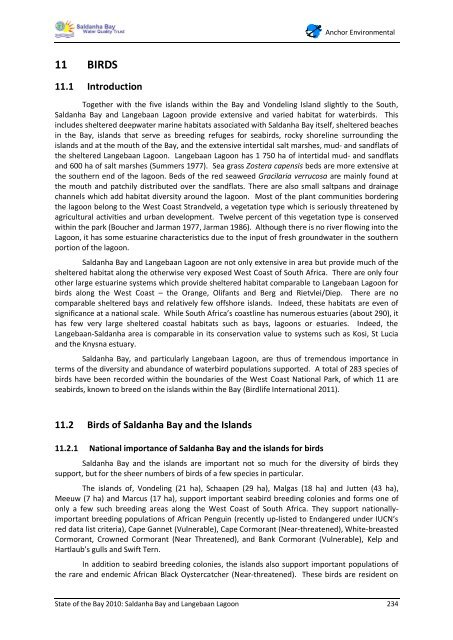State of the Bay Report 2010-Final - Anchor Environmental
State of the Bay Report 2010-Final - Anchor Environmental
State of the Bay Report 2010-Final - Anchor Environmental
You also want an ePaper? Increase the reach of your titles
YUMPU automatically turns print PDFs into web optimized ePapers that Google loves.
11 BIRDS<br />
11.1 Introduction<br />
<strong>Anchor</strong> <strong>Environmental</strong><br />
Toge<strong>the</strong>r with <strong>the</strong> five islands within <strong>the</strong> <strong>Bay</strong> and Vondeling Island slightly to <strong>the</strong> South,<br />
Saldanha <strong>Bay</strong> and Langebaan Lagoon provide extensive and varied habitat for waterbirds. This<br />
includes sheltered deepwater marine habitats associated with Saldanha <strong>Bay</strong> itself, sheltered beaches<br />
in <strong>the</strong> <strong>Bay</strong>, islands that serve as breeding refuges for seabirds, rocky shoreline surrounding <strong>the</strong><br />
islands and at <strong>the</strong> mouth <strong>of</strong> <strong>the</strong> <strong>Bay</strong>, and <strong>the</strong> extensive intertidal salt marshes, mud- and sandflats <strong>of</strong><br />
<strong>the</strong> sheltered Langebaan Lagoon. Langebaan Lagoon has 1 750 ha <strong>of</strong> intertidal mud- and sandflats<br />
and 600 ha <strong>of</strong> salt marshes (Summers 1977). Sea grass Zostera capensis beds are more extensive at<br />
<strong>the</strong> sou<strong>the</strong>rn end <strong>of</strong> <strong>the</strong> lagoon. Beds <strong>of</strong> <strong>the</strong> red seaweed Gracilaria verrucosa are mainly found at<br />
<strong>the</strong> mouth and patchily distributed over <strong>the</strong> sandflats. There are also small saltpans and drainage<br />
channels which add habitat diversity around <strong>the</strong> lagoon. Most <strong>of</strong> <strong>the</strong> plant communities bordering<br />
<strong>the</strong> lagoon belong to <strong>the</strong> West Coast Strandveld, a vegetation type which is seriously threatened by<br />
agricultural activities and urban development. Twelve percent <strong>of</strong> this vegetation type is conserved<br />
within <strong>the</strong> park (Boucher and Jarman 1977, Jarman 1986). Although <strong>the</strong>re is no river flowing into <strong>the</strong><br />
Lagoon, it has some estuarine characteristics due to <strong>the</strong> input <strong>of</strong> fresh groundwater in <strong>the</strong> sou<strong>the</strong>rn<br />
portion <strong>of</strong> <strong>the</strong> lagoon.<br />
Saldanha <strong>Bay</strong> and Langebaan Lagoon are not only extensive in area but provide much <strong>of</strong> <strong>the</strong><br />
sheltered habitat along <strong>the</strong> o<strong>the</strong>rwise very exposed West Coast <strong>of</strong> South Africa. There are only four<br />
o<strong>the</strong>r large estuarine systems which provide sheltered habitat comparable to Langebaan Lagoon for<br />
birds along <strong>the</strong> West Coast – <strong>the</strong> Orange, Olifants and Berg and Rietvlei/Diep. There are no<br />
comparable sheltered bays and relatively few <strong>of</strong>fshore islands. Indeed, <strong>the</strong>se habitats are even <strong>of</strong><br />
significance at a national scale. While South Africa’s coastline has numerous estuaries (about 290), it<br />
has few very large sheltered coastal habitats such as bays, lagoons or estuaries. Indeed, <strong>the</strong><br />
Langebaan-Saldanha area is comparable in its conservation value to systems such as Kosi, St Lucia<br />
and <strong>the</strong> Knysna estuary.<br />
Saldanha <strong>Bay</strong>, and particularly Langebaan Lagoon, are thus <strong>of</strong> tremendous importance in<br />
terms <strong>of</strong> <strong>the</strong> diversity and abundance <strong>of</strong> waterbird populations supported. A total <strong>of</strong> 283 species <strong>of</strong><br />
birds have been recorded within <strong>the</strong> boundaries <strong>of</strong> <strong>the</strong> West Coast National Park, <strong>of</strong> which 11 are<br />
seabirds, known to breed on <strong>the</strong> islands within <strong>the</strong> <strong>Bay</strong> (Birdlife International 2011).<br />
11.2 Birds <strong>of</strong> Saldanha <strong>Bay</strong> and <strong>the</strong> Islands<br />
11.2.1 National importance <strong>of</strong> Saldanha <strong>Bay</strong> and <strong>the</strong> islands for birds<br />
Saldanha <strong>Bay</strong> and <strong>the</strong> islands are important not so much for <strong>the</strong> diversity <strong>of</strong> birds <strong>the</strong>y<br />
support, but for <strong>the</strong> sheer numbers <strong>of</strong> birds <strong>of</strong> a few species in particular.<br />
The islands <strong>of</strong>, Vondeling (21 ha), Schaapen (29 ha), Malgas (18 ha) and Jutten (43 ha),<br />
Meeuw (7 ha) and Marcus (17 ha), support important seabird breeding colonies and forms one <strong>of</strong><br />
only a few such breeding areas along <strong>the</strong> West Coast <strong>of</strong> South Africa. They support nationallyimportant<br />
breeding populations <strong>of</strong> African Penguin (recently up-listed to Endangered under IUCN’s<br />
red data list criteria), Cape Gannet (Vulnerable), Cape Cormorant (Near-threatened), White-breasted<br />
Cormorant, Crowned Cormorant (Near Threatened), and Bank Cormorant (Vulnerable), Kelp and<br />
Hartlaub’s gulls and Swift Tern.<br />
In addition to seabird breeding colonies, <strong>the</strong> islands also support important populations <strong>of</strong><br />
<strong>the</strong> rare and endemic African Black Oystercatcher (Near-threatened). These birds are resident on<br />
<strong>State</strong> <strong>of</strong> <strong>the</strong> <strong>Bay</strong> <strong>2010</strong>: Saldanha <strong>Bay</strong> and Langebaan Lagoon 234

















